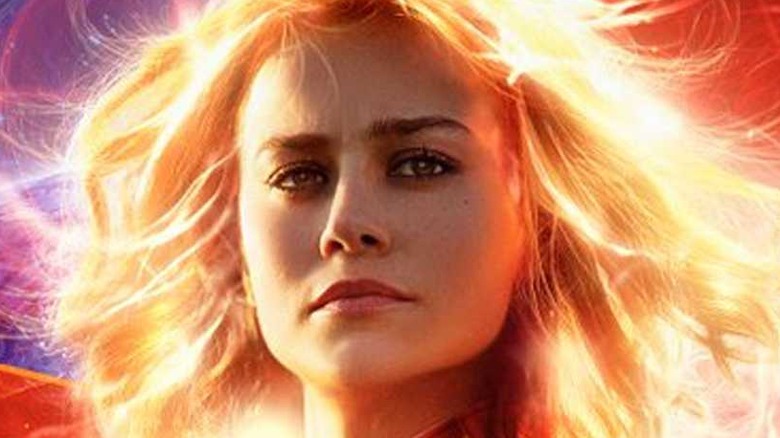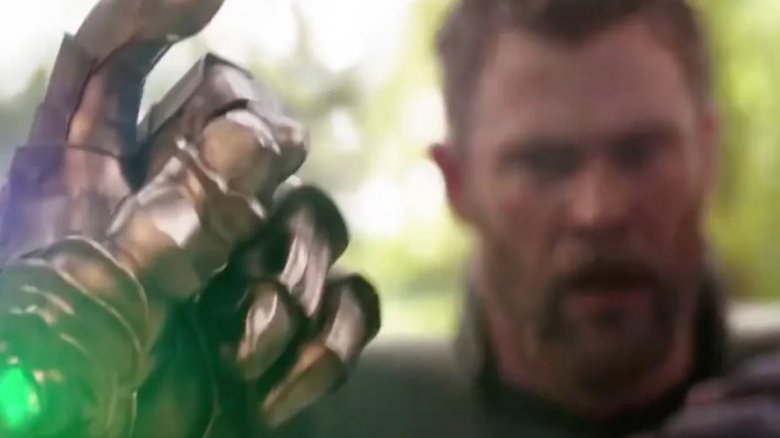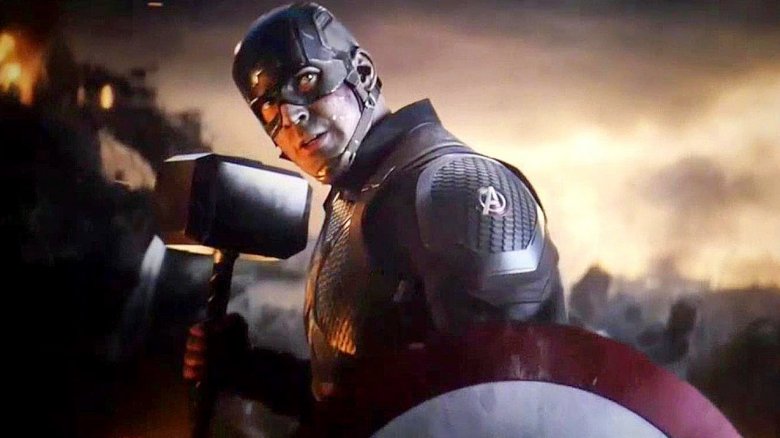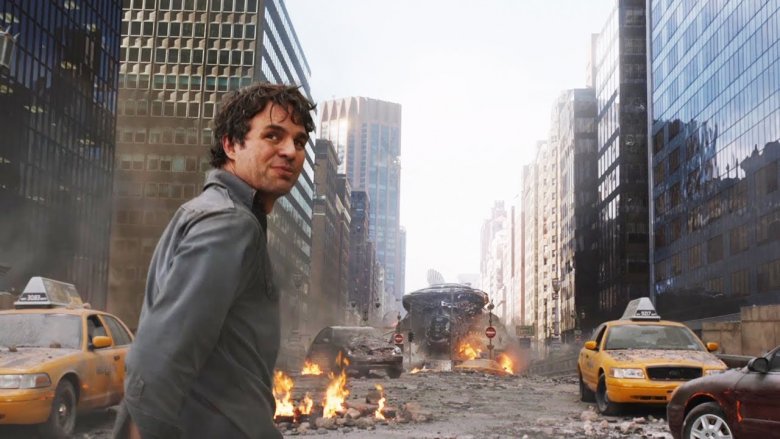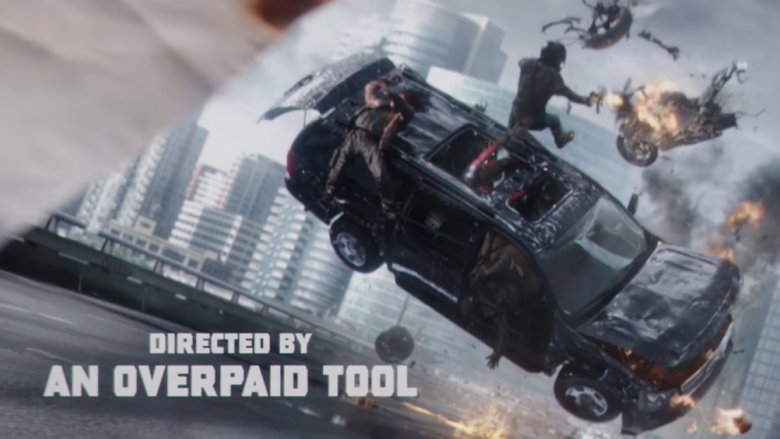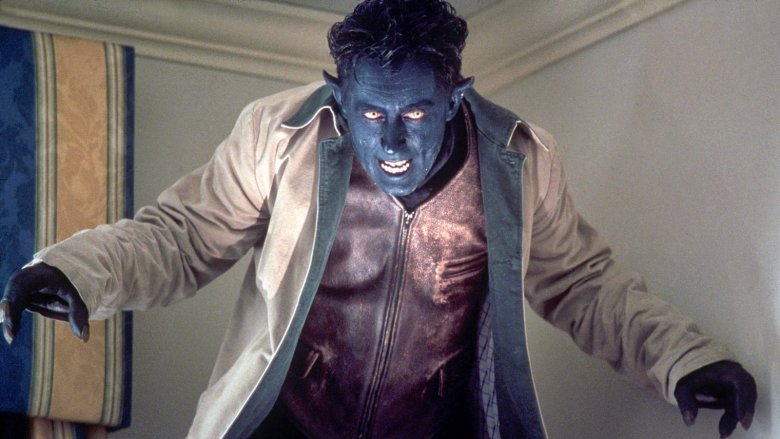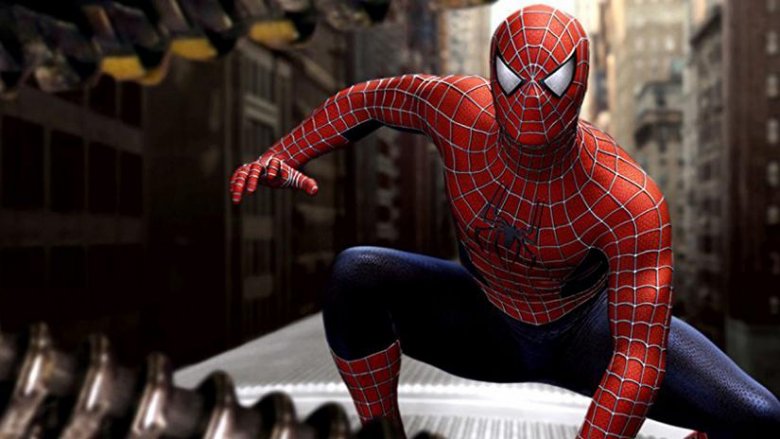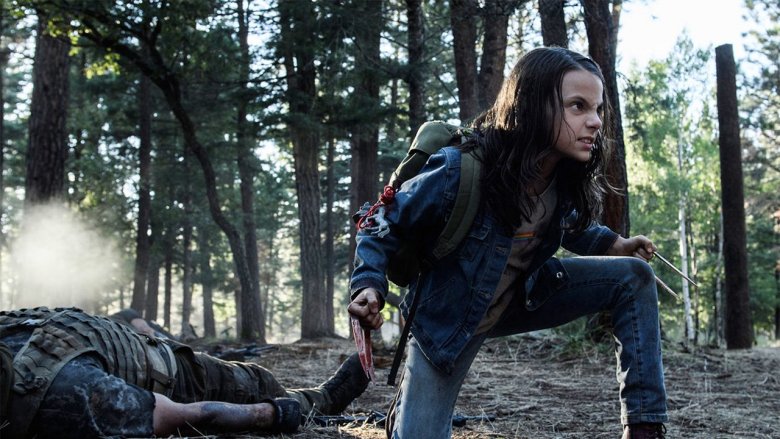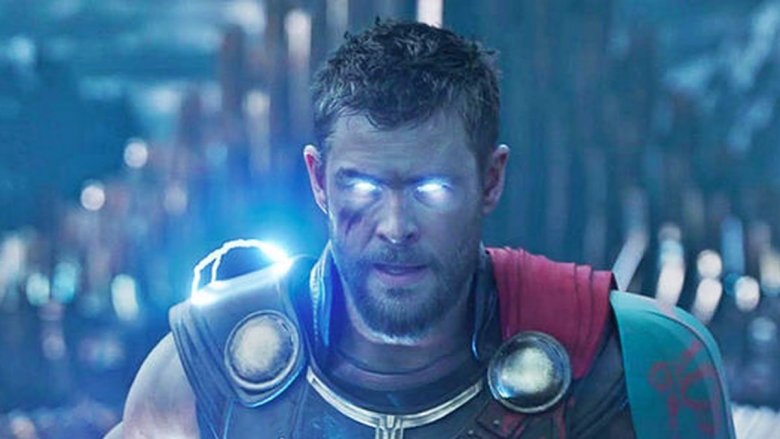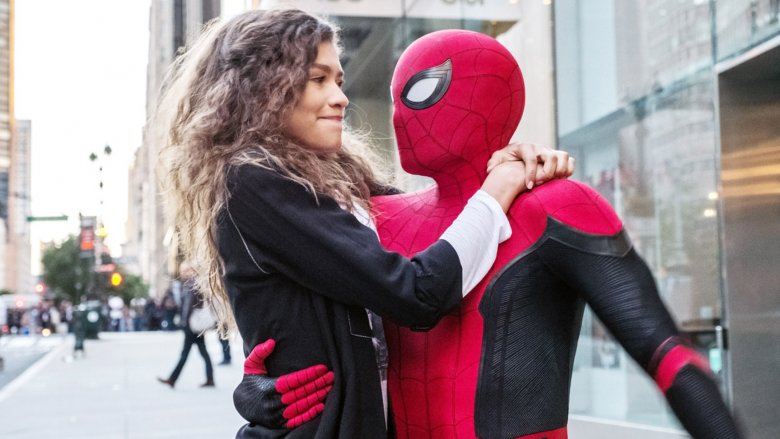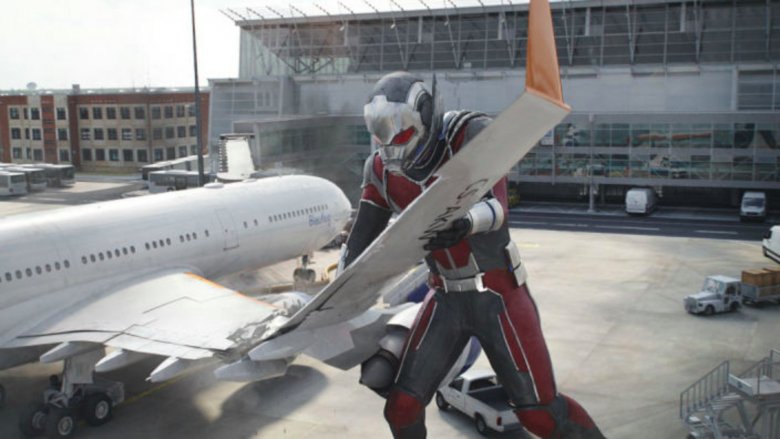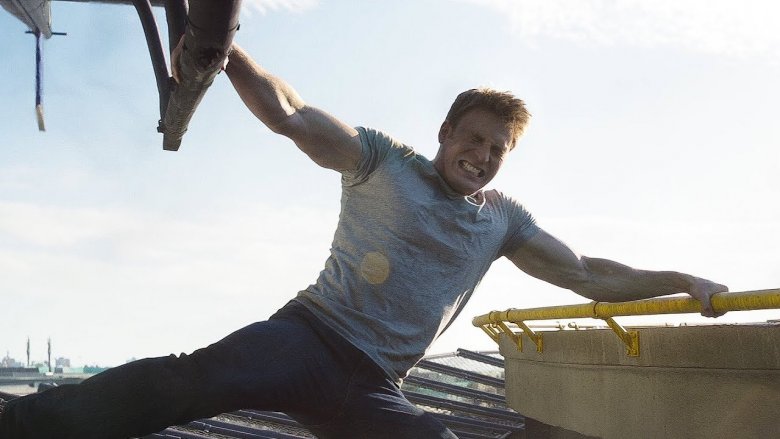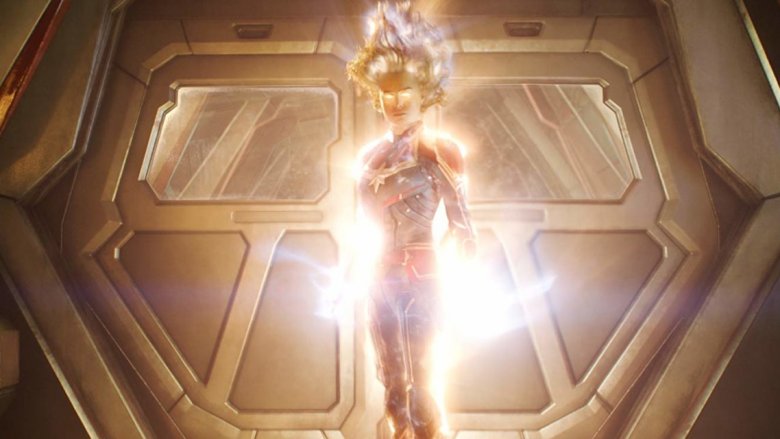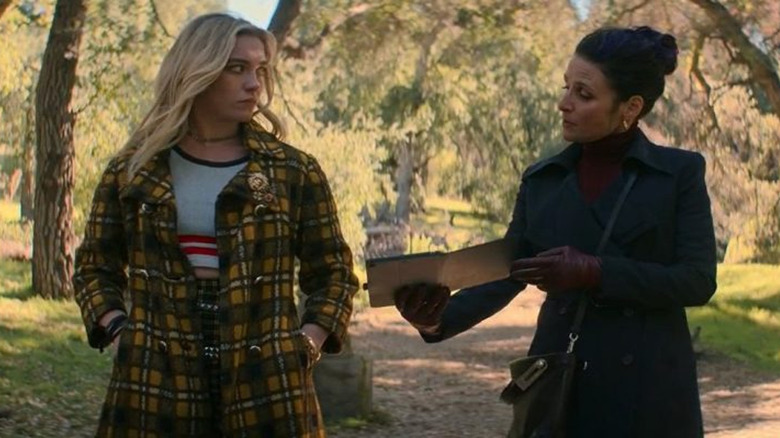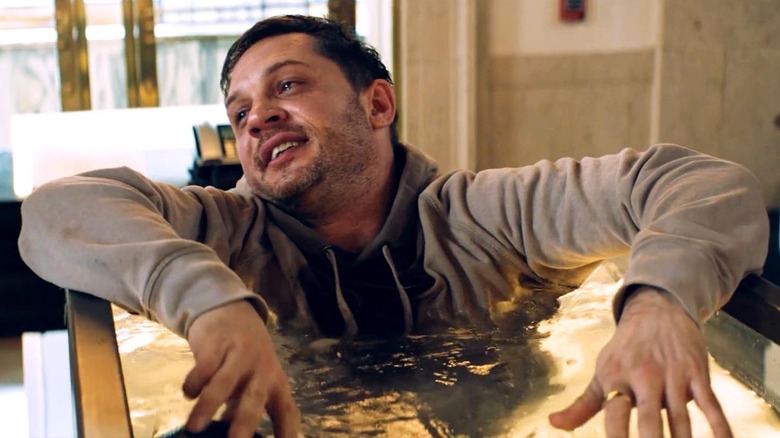The Very Best Jaw-Dropping Moments In Marvel Movies
We've been watching the superheroes of Marvel Comics light up the big screen for over two decades now, from the earliest adventures of Blade to the universe-altering finale of Avengers: Endgame. Though they're not all part of the same universe, the Marvel-inspired blockbusters have brought in billions of dollars at the box office, delivered countless live-action versions of heroes and villains, and conjured whole worlds into existence. That means they're packed with meaningful, hilarious, thrilling, and sometimes downright jaw-dropping moments.
Yes, even now, after the epic crossover known as the MCU Infinity Saga has come to a close, these moments are still capable of putting our jaws on the floor. Some achieve that through carefully orchestrated comedy, others through action prowess, and still others through sheer displays of raw power. Whether they were delivered by Spider-Man, Wolverine, or Captain Marvel, these are the biggest jaw-dropping moments from Marvel movie history.
The Snap sends shock waves across the Marvel Cinematic Universe
We all thought we knew the formula for an Avengers adventures when we sat down to watch Avengers: Infinity War. We expected Earth's Mightiest Heroes to have a tough fight against Thanos, of course. And perhaps they wouldn't escape the fight without losing one or two members of the team, but even if they didn't win, they would at least find a way to prolong the battle until the sequel. Surely Thanos wouldn't walk away the victor, right?
And yet, as thunder echoed through the Marvel Cinematic Universe, Thanos' dream of ending half of all life in the universe was realized. Audiences around the world watched in horror as everyone from Black Panther to Spider-Man dissolved into dust before their very eyes. It was a snap heard 'round the universe, one that continues to echo through the MCU and our imaginations to this day, in part because of the effectiveness of the character deaths, but also because before it happened, we simply couldn't see the MCU heroes actually falling so hard, so fast.
Cap is worthy
Avengers: Endgame was a film that had to follow Thanos' snap by both meditating on the fallout of the tragedy and finding ways to rise above it. As a result, it's a movie packed to the rafters with potentially jaw-dropping moments, and we could've discussed any number of them here. But if we're going to talk about the moment our jaws absolutely hit the floor, we're going to have to skip over the female team-up sequence and Captain Marvel's entrance and even Thanos' death in the opening minutes, and jump right to Captain America wielding Mjolnir.
What makes it so impressive is how the movie telegraphs what's about to happen right before Cap wraps his hand around the hammer. It's clear what the action sequence is building towards, with Thor helpless under Thanos' weight and Mjolnir's clear movement towards somebody's hand. Plus, the camera isn't showing us what Cap is doing in that moment. But when it happens, even though we've so obviously been set up for it, it's still such a massive payoff that we can't help but cheer. The fireworks Cap unleashes on Thanos immediately after getting the hammer don't hurt, either.
Bruce Banner is always angry
There were many, many narrative challenges at work in Joss Whedon's The Avengers. The film had to successfully convey Loki as a villain big enough for all six heroes, convincingly bring the group together amid tension, and then show us that they were a true team after several films had established the distinct personality of each character. It also had a to give us a new version of the Hulk with Mark Ruffalo's Bruce Banner.
And yeah, the movie totally succeeded when it comes to the big green guy.
Hulk's whole arc in the film, from sad scientist to reluctant hero, is magnificent, but his biggest moment comes when Banner finally arrives at the final fight after falling from the Quinjet earlier in the film. Surrounded by the ruins of mid-battle New York, he utters his famous line, "That's my secret, Cap. I'm always angry," and then lets loose with a punch that shows the Chitauri, and audiences, what they're dealing with. Hulk's had plenty of great moments since then, but none quite as potent as this little calling card.
Deadpool has marvel-ous opening credits
Deadpool is a film that finally made it to theaters after a now-legendary reel of test footage leaked onto the internet and showcased the mix of tongue-in-cheek meta-humor and ultraviolence that would come to define the character's big screen brand. That test reel could've easily been the sum total of the project's creativity, a sizzle reel stretched out for two hours that ultimately amounted to nothing, but Deadpool had bigger ambitions. To pull the effort off, the film had to make its joke-a-minute formula work on every possible level for the full runtime.
And as it turns out, everything clicked from the moment the opening credits started rolling.
So let's set the scene. As "Angel of the Morning" plays, we track through a frozen tableau of carnage. We see everything from a Green Lantern trading card to a goon with a cigarette lighter burn on his forehead. And all the while, jokey credits are telling us the film stars "God's Perfect Idiot," and that it's directed by "An Overpaid Tool." It's a perfect introduction to what we're about to see, and it's such a perfectly constructed little sequence that you can't help but sit in awe of its detailed construction.
Nightcrawler's entrance is a truly awesome moment
X2: X-Men United is among the best of Fox's X-Men films because it's a movie that retains what we liked about the first X-film while upping the ante in just about every respect. It does this by giving new focus to Wolverine and Rogue, but also by introducing new characters with dazzling abilities and raising the stakes on almost every action set piece. While Magneto's prison escape is a favorite scene for some fans, for others, the undisputed champion of this film happens right in the opening, when Nightcrawler breaks into the Oval Office on a mission to assassinate the president.
We later find out that Nightcrawler has been brainwashed, and that his plight is at the center of a massive conspiracy to rid the world of mutantkind. We also later find out that he's a nice guy who'd never deliberately do what he did in the opening minutes. But that doesn't stop the sequence from remaining a fantastic moment even now, after years of superhero films raising the stakes on each other.
Spider-Man saves the train and makes Marvel movie history
Spider-Man 2 has since been followed by six other Spider-Man films, four of which starred other actors as live-action Peter Parker. But for many fans, Sam Raimi's sequel remains the gold standard for both Spidey and superhero movies because of its tremendous emotional core and sense of action. That all comes together in the still-legendary sequence where Spider-Man has to stop a runaway train after Doctor Octopus sabotages the controls to make his escape.
Though it would later be topped in scope by the ferry sequence in Spider-Man: Homecoming, Raimi directs the heck out of the train rescue, in which Peter Parker, unmasked and desperate, sticks his webbing to various passing buildings in an effort to make a sling with his own body to catch the train. It's still an edge-of-your-seat sequence more than a decade later. What really seals this moment's place as a jaw-dropper, though, comes after the rescue is complete, when Peter passes out from sheer exhaustion and wakes to find all the train passengers looking at him, mask off. They're so grateful for his help, and so understanding of how important Spider-Man is to their city, that they hand back his mask and promise to never tell anyone who he is. It brings such emotional weight to the action that you can't help but be spellbound.
Logan's last stand is a jaw-dropping finale
Logan is not a particularly complex film by comic book movie standards. It's not introducing multiple heroes and asking them to prepare for a final, apocalyptic battle at the end. It is, at its heart, a movie about a man who's waiting to die but finds a reason to live a little longer. In that sense, it's quite easy to follow the emotional core of it, even as you keep waiting for certain key superhero moments to happen — in particular, some kind of father-daughter team-up between Logan and his young clone, Laura.
When it finally does happen, near the end of the film in a forest, we've been waiting for Logan and Laura to rip into things side-by-side for so long that the film has both successfully built anticipation and added a clear layer of sadness to the moment. When Laura realizes Logan has her back, it's a moment of tremendous emotional payoff, but when you realize Logan's body is filling up with bullets, you understand this isn't going to end like a lot of other superhero fights. The whole sequence is a tremendous merging of action and emotional intensity that's a perfect climax for one of the greatest superhero films ever made.
Thor: Ragnarok finishes strong
Thor: Raganrok is a film with the ambitious agenda of rethinking the way we see both Thor and the world that surrounds him, and as a result, it's a movie full of fresh sights and sounds that offer a lighter and yet more emotionally resonant take on the god of thunder. There are a number of absolutely dazzling moments in the film, but in terms of truly mind-blowing movie scenes, we have to talk about that final fight.
As Hela's armies close in on his friends, an injured, one-eyed Thor is desperate for some kind of help. Then he thinks of his father's words, realizes his power comes from within, and unleashes a lightning bolt that slows Hela down and allows him to join the fight on the Rainbow Bridge. At that moment, Led Zeppelin's "Immigrant Song" hits, and we're treated to shot after shot after delight. Thor twists in the air like M. Bison from Street Fighter. Valkyrie strolls up the bridge with fireworks going off behind her. Loki uses the horns of his helmet as weapons. And, of course, Hulk suplexes a giant zombie wolf. It's all jaw-dropping and grin-inducing at the same time.
Spider-Man: Far From Home's mid-credit meltdown
Spider-Man: Far From Home establishes that the MCU's version of Peter Parker does indeed have a spider-sense, which his aunt has helpfully nicknamed "the Peter Tingle." He also apparently has the legendary Parker luck, because just when you think the kid has caught a break, the film pulls the rug out from under him, and to make things even more jaw-dropping, it does so right in the middle of the credits.
By the end of Far From Home, everything seems to be going well for Peter. He's in a relationship with MJ, all of his friends made it home from Europe safe, and he's cemented his place as Tony Stark's successor in the MCU with the help of Happy Hogan. That all comes crashing down when it's revealed via J. Jonah Jameson that Mysterio used the final minutes before his death to record himself saying Spider-Man's real name, and that the footage has now been broadcast to the world.
First of all, the introduction of J. Jonah Jameson all by itself was enough to put jaws on the floor, but then the scene went further to completely obliterate Peter Parker's life as we now know it. The next time we see him, his life is going to be completely different, and it's all thanks to this one scene.
Giant-Man rising is a classic Marvel movie moment
A film like Captain America: Civil War is built for big surprise moments. We knew going in that it would introduce the likes of Black Panther and Spider-Man to the MCU, and that it would pit various heroes against each other in a super vs. super battle unlike anything we'd seen in the universe up to that point. Stakes that big invite moments that drop jaws, but we had no way of knowing exactly which moments would drop them the lowest until we saw the flick.
Going in, if you had to guess, you might've thought Spider-Man grabbing Captain America's shield would be the coolest moment, but that wasn't the case. In the end, the biggest moment turned out to be the biggest in a very literal way. And yeah, we're talking about the scene when Scott Lang reveals that he's capable of growing his body to gigantic size. This dude shoots up several dozen feet during the airport fight and grabs War Machine like he's nothing but an action figure. And while he reappears in both Ant-Man and the Wasp and Avengers: Endgame, this Giant-Man moment will always hold a special place in our hearts, in part because he ends his adventure by asking if anyone has orange slices.
Captain America vs. a helicopter is an epic superhero scene
Steve Rogers is not a superhero in the same sense that someone like Thor or the Hulk is, nor is he an ordinary man in the same way that Tony Stark is. Steve Rogers' treatment with the Super Soldier Serum has, according to comic book lore, enhanced his body to the point that he's essentially reached maximum human potential in terms of strength, speed, endurance, and more. He's quite literally the best version of a normal human being without any external enhancements, and because he has the heart and determination of Steve Rogers, he's able to push himself to the point where even other enhanced humans wouldn't be able to go.
This is perhaps best exemplified in Captain America: Civil War, when Cap single-handedly holds a helicopter in place mid-takeoff for several seconds, using nothing but his grip strength and his willpower. Even for Cap, it's quite a feat, and Chris Evans' innate ability to make his biceps absolutely pop during that sequence is enough to knock your jaw to the floor.
Captain Marvel takes on a spaceship
Captain Marvel arrived in the MCU at a time when Thanos had already snapped, when the Avengers had already assembled three times, and when we'd already seen things like Vision and Giant-Man walking through the frame. Despite all of this, the film's mission was to convince us that we were witnessing the creation of the MCU's most powerful hero, someone stronger than virtually any other Avenger in the room, and it had to do that while also showing us that she was capable of a meaningful struggle.
So how did Captain Marvel convince us that Carol Danvers was not to be messed with? Simple. By having the hero defeat an army all by herself. If you need a refresher, after choosing to defend the persecuted Skrulls, Captain Marvel takes out an entire Kree squadron and then flies herself, fully charged with energy, through a massive Kree warship, exploding it in seconds and sending the surviving bad guys packing. And from that point on, there's absolutely no doubting that Carol Danvers is a force to be reckoned with.
Black Widow takes aim at the future
Marvel's Black Widow functions largely as a prequel, filling in Natasha Romanoff's past with a story that falls between Captain America: Civil War and Avengers: Infinity War. But that doesn't mean the film isn't also eager to look to the future. One of its most vital characters is Natasha's "sister" Yelena Belova, played by Florence Pugh. Like Natasha, Yelena is a Red Room-trained assassin with deadly skills that she's recently learned to use on her own terms, and by the end of the film, she seems primed to perhaps take her place as the MCU's next Black Widow.
Then comes the post-credits scene, when Yelena — now in America, visiting Natasha's grave in her adoptive homeland of Ohio — is approached by Valentina Allegra de Fontaine (Julia Louis-Dreyfus), the shady spymaster whose motives in the MCU are still rather murky. It turns out Yelena's been working with Val for some time in the aftermath of the Blip (the in-universe name for Thanos' Snap), and Val has a new target for her: the man who Val says killed Yelena's sister, Clint Barton (Jeremy Renner).
So the stage is set for the heir to the Black Widow mantle to take on Hawkeye himself, her sister's best friend who fought like hell to actually stop Natasha from sacrificing herself in Avengers: Endgame. In a movie full of big reveals about Natasha's past and what that all means for the MCU's future, this was the moment that truly left jaws on the floor, previewing a showdown that will either end in friendship or in blood.
Venom's feeding frenzy
No one knew quite what to expect from Venom, the first solo film to star the title antihero, a combination of a man named Eddie Brock (Tom Hardy) and a sentient alien symbiote that bonds with his body. Would it be overly dark and gritty? So self-serious that it became silly? Too focused on its creature to add any real humanity? It was a film that felt hard to pin down in its marketing, which is why it was so refreshing to watch what we got: a quirky blend of darkness, action, and surprisingly self-aware humor.
Venom begins as a sort of body horror film, as Eddie accidentally comes across the symbiote and then struggles to understand why there's suddenly a voice in his head and all sorts of strange symptoms moving through his body. It's an adjustment period that manifests itself in all kinds of way, but the most memorable one arrives when Eddie storms into a fancy San Francisco restaurant in an effort to confront his former partner (Michelle Williams) with the discoveries he's made. Of course, the Venom symbiote has other plans, and by the end of the scene Eddie has submerged himself in a live lobster tank like he's in a spa. The moment just gets weirder when Eddie snatches up one of the crustaceans and has a little raw seafood lunch while all the diners watch.
Though Venom certainly has flashier moments along the way, this is the one that set the tone for what this particular superhero franchise wanted to be: Funny, unpredictable, and more than a little bizarre.
